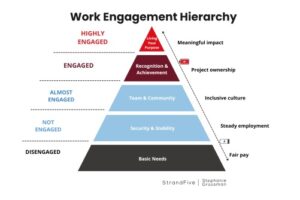 The Illusion of “Fine”
The Illusion of “Fine”
A leadership team gathers for its weekly meeting. Status updates are crisp. Next steps are clear. No friction. No questions. The meeting ends early. On the surface, everything looks fine. But three years ago, that same meeting sparked animated debates, collaborative problem-solving, and surfaced meaningful insights. The team wrestled with the hard stuff—together. There was energy in the room. Now, it’s quieter and smoother, but not better. It passes for productivity, yet the edge that once moved things forward is gone. This is what disengagement looks like when it becomes normalized. And the shift often goes unnoticed until it’s already set in.
According to Gallup, U.S. employee engagement has fallen to just 31%, the lowest level in more than a decade. Globally, engagement dropped to just 21% in 2024, with disengagement costing the economy $438 billion in lost productivity.
At the same time, researchers at Deloitte and McKinsey point to growing execution gaps as teams struggle with change and ambiguity.
Organizations navigating continuous change lose the alignment, clarity, and trust needed to keep people connected. This creates what Gallup calls The Great Detachment: people still showing up and doing their jobs but no longer feeling connected to the purpose behind them.
The business case for engagement is clear. Highly engaged teams see 23% higher profitability, 18% higher productivity, and 10% better customer ratings.
But the real warning signs aren’t in the metrics. They’re in the moments when no one speaks up.
A VP of product presents the roadmap. There are known concerns, but no one raises them. Not because they’re afraid to speak up, but because they’ve stopped believing it will make a difference. The discussion ends. Teams move forward quietly, then execute without energy or conviction. This reflects the true nature of disengagement: it’s the withdrawal of discretionary effort that once made excellence possible.
What Fuels Engagement
Engagement isn’t driven by motivation alone. It’s shaped by the conditions people are working in. Even the most committed team members disengage when they’re forced to deal with unnecessary complexity. According to Deloitte, employees spend too much time on work that doesn’t create value for their organizations. Engagement erodes when people spend more energy navigating barriers than applying their talents.
You can create better conditions for engagement by prioritizing clarity, trust, consistency, and supportive systems.
Clarity
Clear, purposeful communication helps people understand:
• What direction the organization is taking and why it matters
• How initiatives connect to broader goals
• How their work contributes to meaningful outcomes
Trust
Trust deepens when leaders:
• Share decisions and the reasoning behind them
• Foster a culture that invites honest input, without risk
• Show up consistently in both words and actions
Consistency
Leaders reinforce engagement when they:
• Maintain predictable communication rhythms
• Create reliable channels for information to flow
• Uphold development and support commitments—even as priorities shift
Systems
Effective systems reduce drag and enable meaningful contribution by:
• Streamlining approvals to speed up decision-making
• Providing timely access to the right information
• Minimizing administrative burden so effort goes to work that matters
Where to Look for the Gaps
Disengagement doesn’t always show up in performance reviews. It hides in the difference between the minimum required effort and full commitment:
- New challenges met with hesitation instead of initiative
- Ideas landing with passive acceptance rather than debate
- Independent work favored over collaboration
These signals of disconnection point to real opportunities for change.
Leadership That Reconnects
When leaders focus on clarity, trust, consistency, and supportive systems, people will begin to reconnect with the work they find purposeful and rewarding. And in an environment defined by uncertainty, that’s what makes performance sustainable
“Fine” is where disengagement takes hold. People do the work, but stop bringing the initiative that made it better. It doesn’t show up in metrics right away, but it shows up.